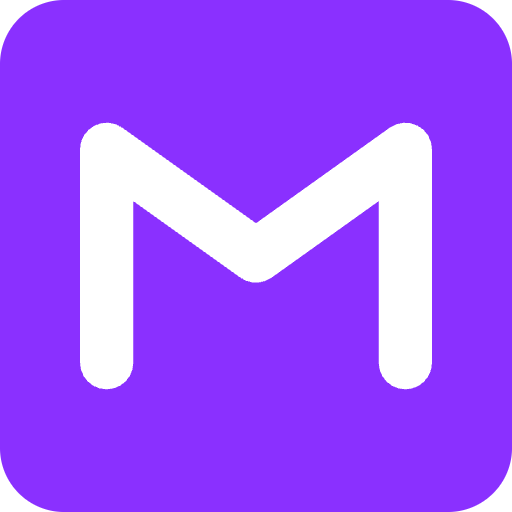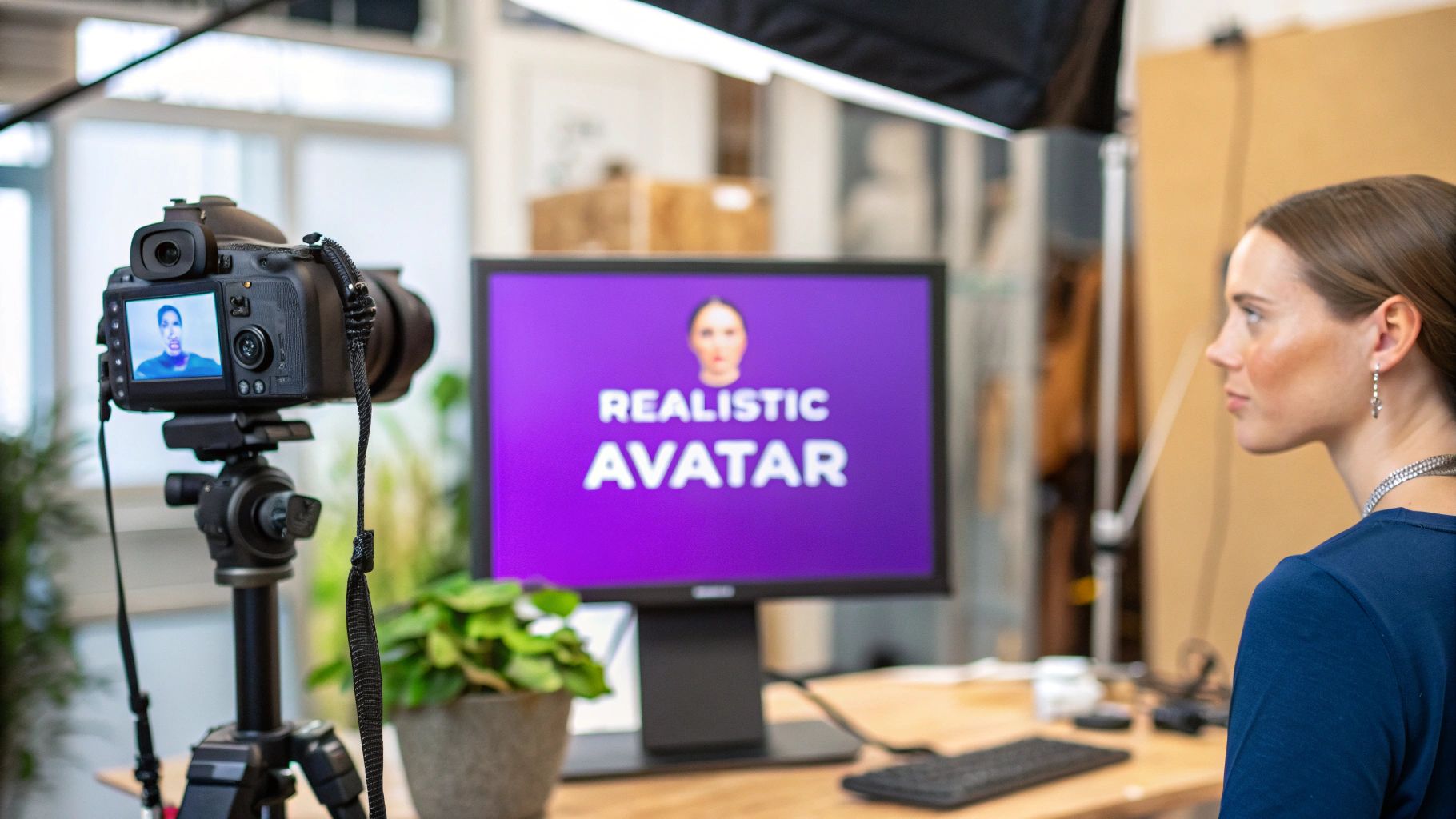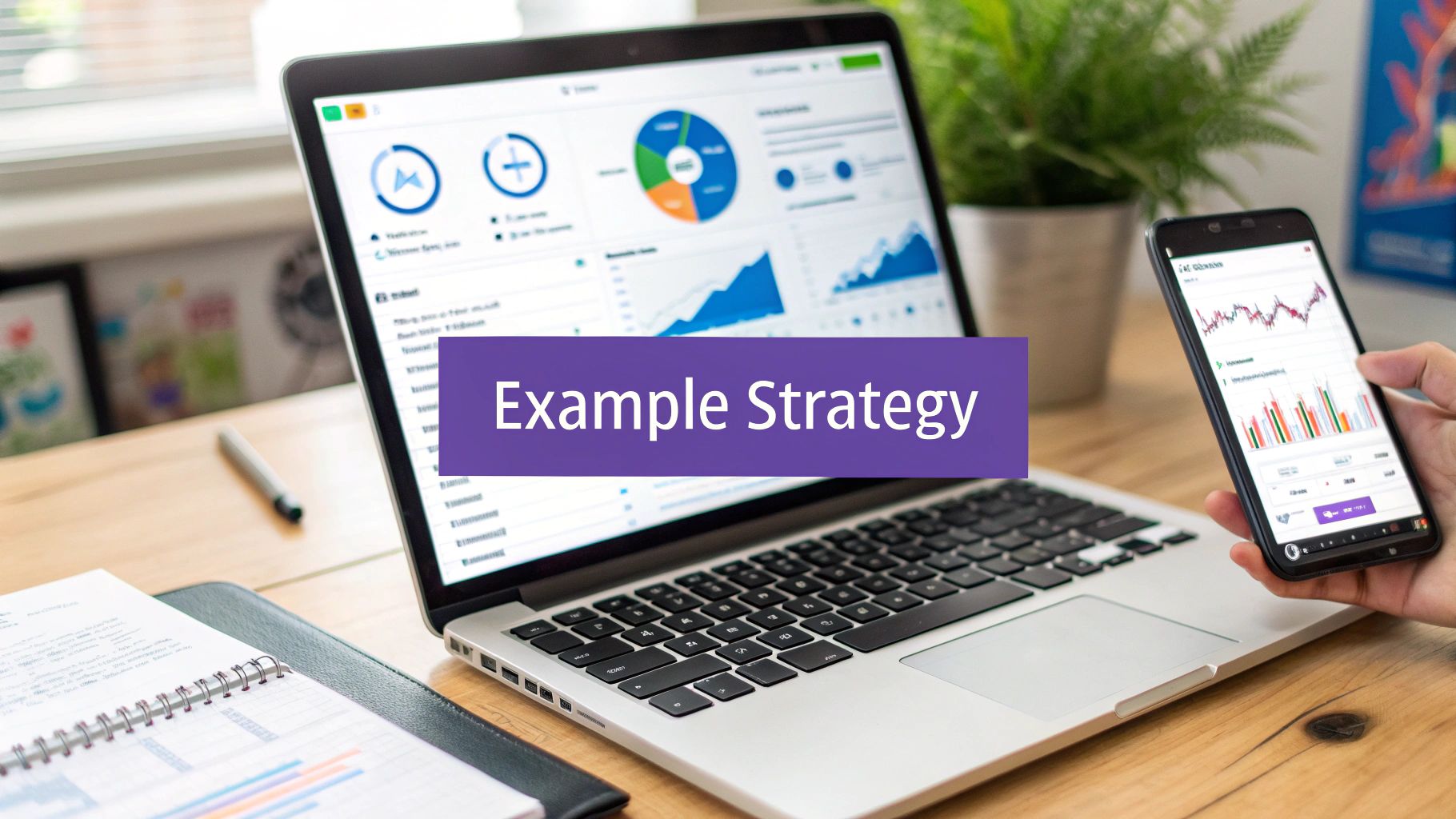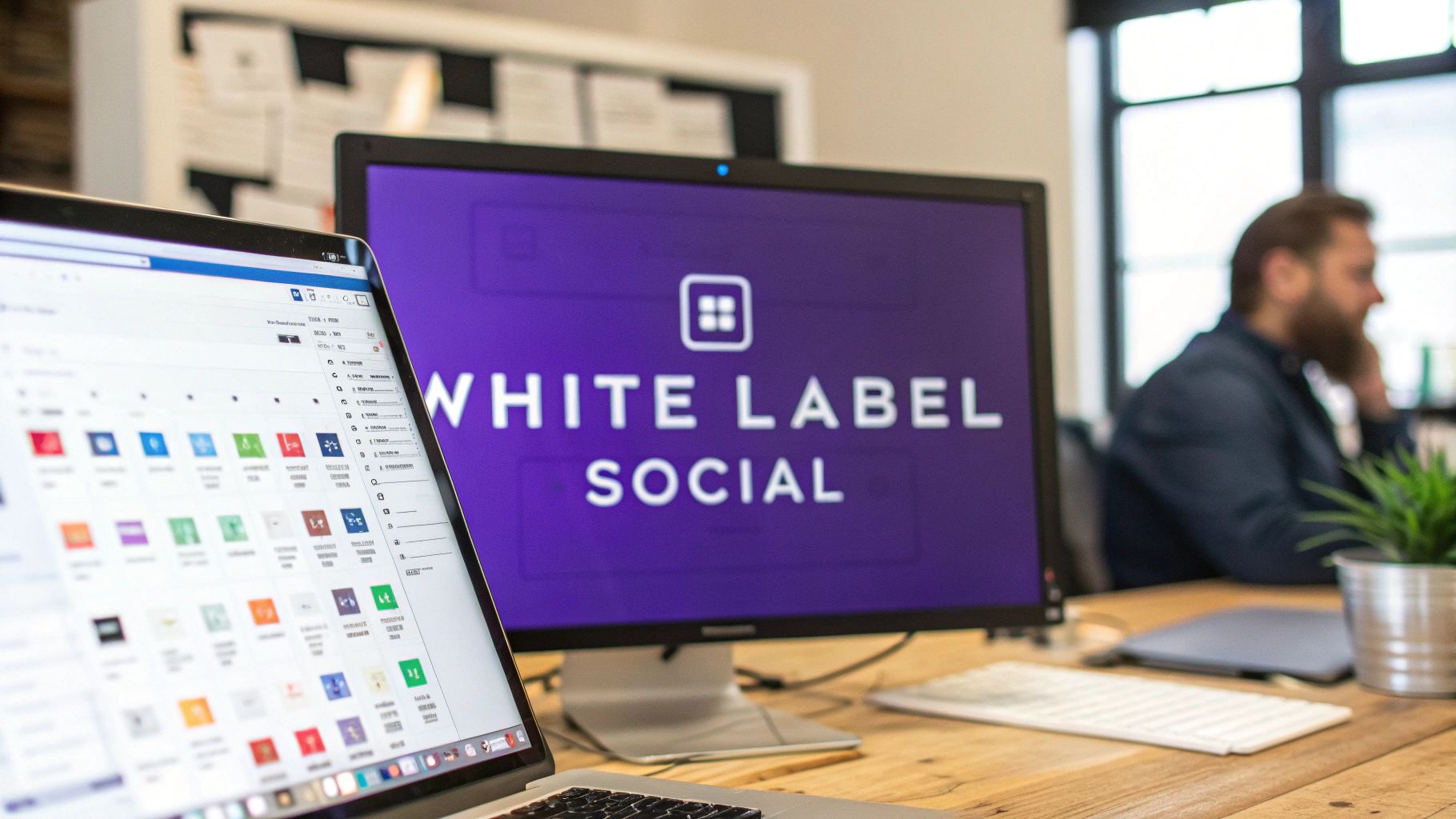Your Social Media Content Calendar Blueprint
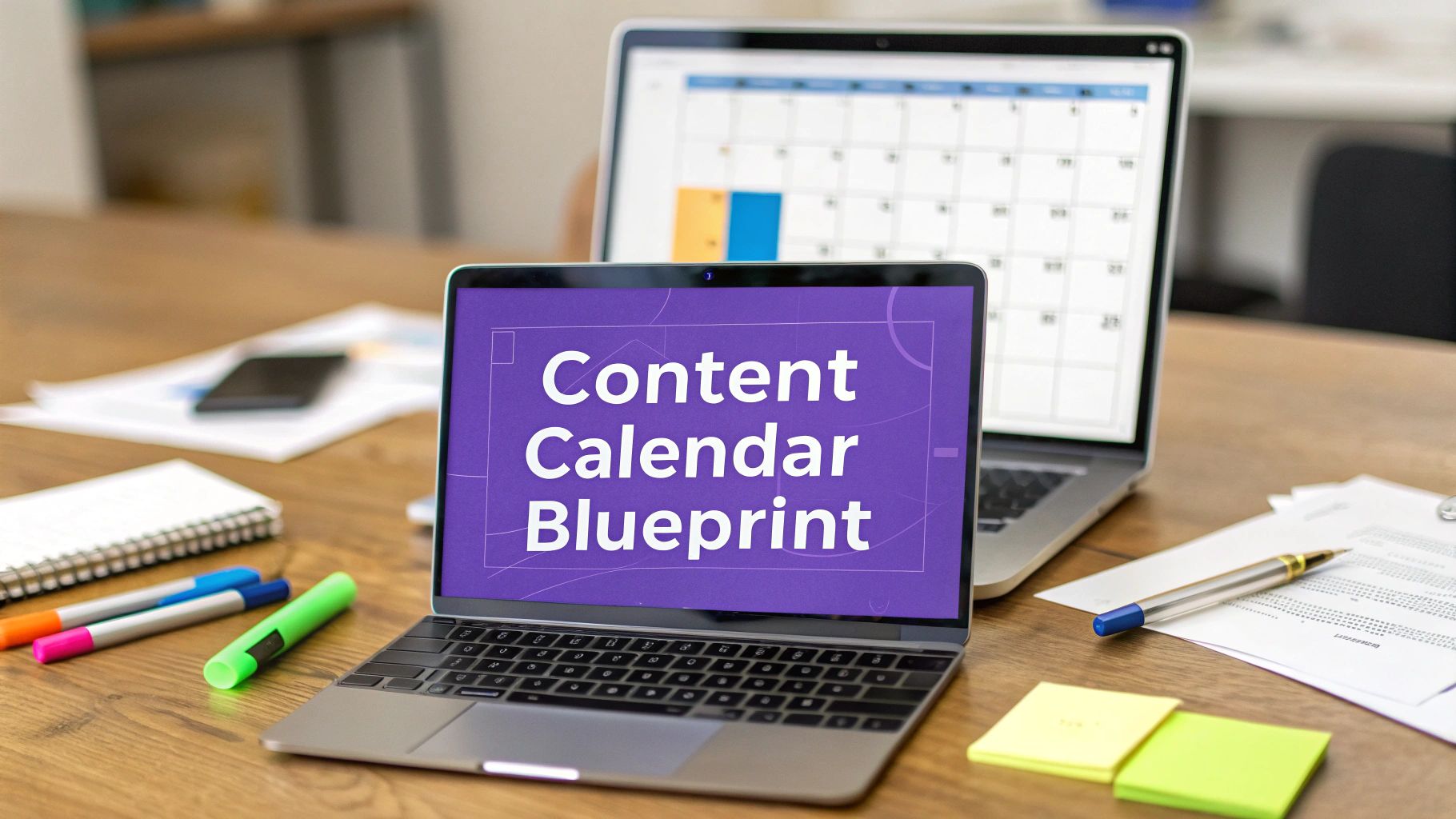
A social media content calendar is the strategic schedule that dictates when and where you publish content. Think of it as your brand's master plan, the tool that moves you from chaotic, last-minute posting to a cohesive and impactful social media presence.
Why Your Strategy Needs a Content Calendar

Let’s reframe this. A content calendar isn't just an organizational tool; it’s your strategic command center. Without one, you're essentially flying blind in the fast-paced world of social media, reacting to the day instead of executing a thoughtful plan. The top brands I've worked with get this—they use their calendars to build a powerful, cohesive narrative that truly connects with their audience.
This deliberate approach turns social media from a daily chore into a measurable driver of business growth. A well-built calendar is how you unlock several core benefits that directly impact your bottom line.
A content calendar gives you a bird's-eye view of your entire social media strategy. This high-level perspective is essential for making sure every post, every campaign, and every piece of content works together to achieve your broader marketing goals. Instead of just filling a slot, you're building a narrative.
Here’s a quick look at the main advantages of putting a calendar at the heart of your social media efforts.
| Core Benefits of a Strategic Content Calendar | | :--- | :--- | | Benefit Category | Strategic Impact | | Brand Consistency | Ensures a unified brand voice, visual identity, and messaging across all posts, building trust and recognition. | | Workflow Efficiency | Creates a single source of truth for teams, clarifying roles, simplifying approvals, and reducing errors. | | Strategic Planning | Allows for proactive capitalization on trends, holidays, and key cultural moments with high-quality campaigns. | | Performance Tracking | Provides a clear framework for analyzing what works and what doesn't, enabling data-driven improvements over time. |
Ultimately, a calendar moves you from a reactive, "post-and-pray" approach to a proactive, strategic one that delivers measurable results.
Achieve Unwavering Brand Consistency
Your social media is often the first place a potential customer interacts with your brand. A content calendar guarantees that every post, story, and video aligns with your established brand voice, visual identity, and core messaging. This is how you build trust and recognition.
Imagine a fitness brand that posts a serious, scientific breakdown of a workout one day and a low-effort, unrelated meme the next. That kind of erratic tone confuses followers and weakens the brand's authority. A calendar enforces consistency, making sure every piece of content supports the bigger brand story.
A proactive, calendar-driven strategy allows you to turn social media into a reliable asset for achieving specific marketing goals, rather than a frantic, resource-draining activity.
Streamline Team Collaboration and Workflow
For marketing teams, a shared content calendar is the ultimate source of truth. It cuts through the noise and eliminates confusion by clearly mapping out responsibilities, deadlines, and the status of every single content piece.
- Clarity on Roles: The copywriter, graphic designer, and social media manager all know their exact part in the process.
- Simplified Approvals: Managers can review and approve content in organized batches, which saves a massive amount of time.
- Reduced Errors: With a clear plan laid out, the risk of duplicate posts or publishing unapproved content drops to virtually zero.
This structured workflow liberates your team from administrative headaches, freeing them up to focus on what they do best: being creative and strategic.
Capitalize on Trends and Key Moments
A content calendar is a marketer's best friend for planning around key dates, cultural moments, and seasonal trends. For 2025, for instance, smart brands are already using calendars that map out major holidays and niche celebrations. Those smaller, niche moments can create incredibly powerful connections within specific communities.
You can get more insights into the 2025 social media landscape and its unique opportunities over at Vamp.com. By planning ahead, you can develop high-quality, relevant campaigns that tap into existing conversations, driving both engagement and visibility when it matters most.
Gathering Your Essential Calendar Ingredients
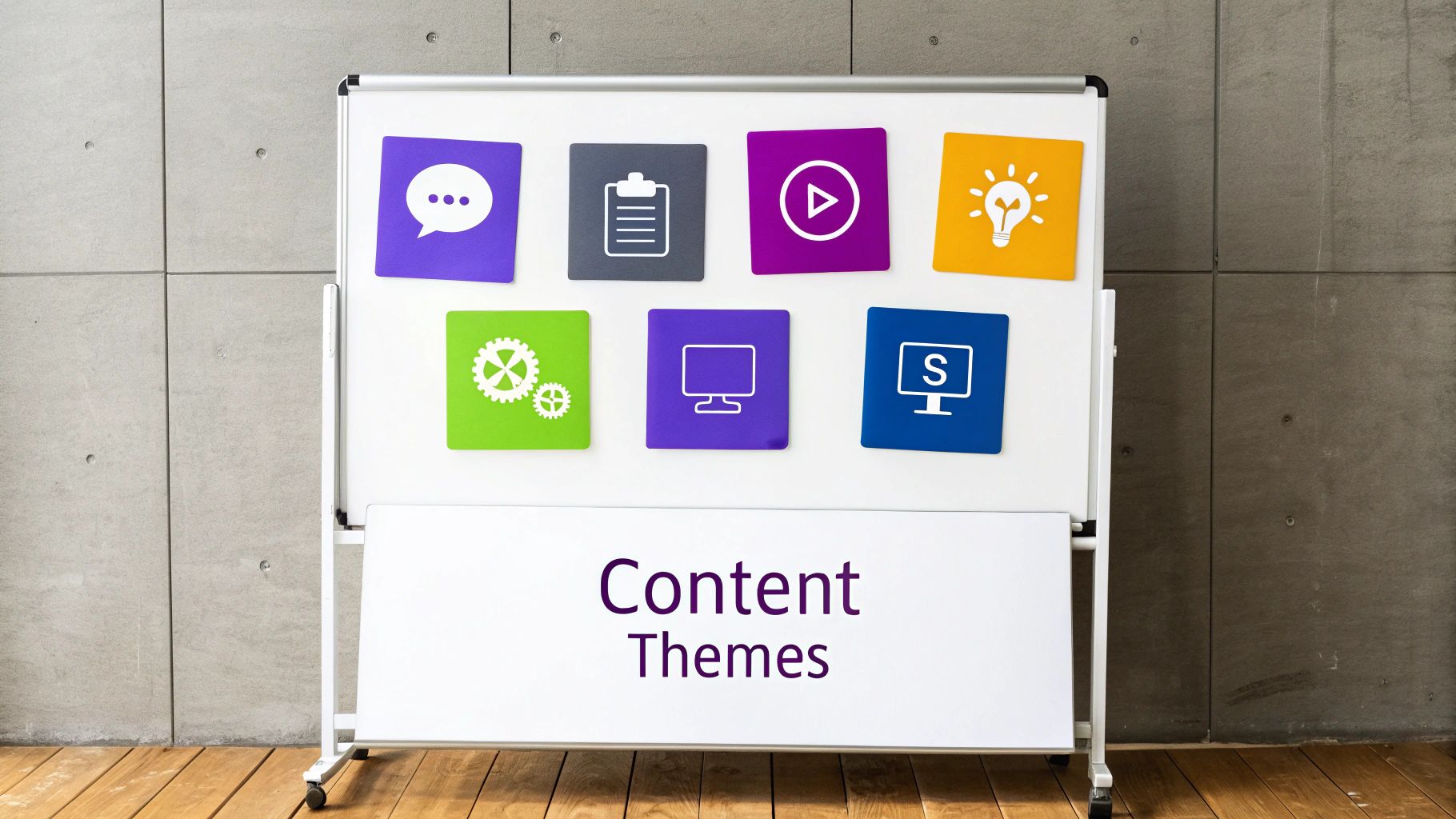
Before you ever plot a single post on your calendar, you need to get your strategic ingredients in order. Think of it like a chef’s mise en place—getting all your components prepped and ready makes the actual cooking (or in our case, content creation) incredibly smooth and far more effective.
The first step is always to look backward before you can move forward. This means doing a practical, honest audit of your existing social media channels. You need to know what’s actually working and what’s just taking up space on the feed. Dive into your analytics and pinpoint your highest-performing posts from the last quarter.
But don't just stop at vanity metrics like likes. Figure out which posts sparked genuine conversations, earned shares, and, most importantly, drove clicks to your website. This data gives you a solid baseline, preventing you from building a new strategy on guesswork instead of what your audience already loves.
Define Your Goals and Audience
With your performance data in hand, it's time to set clear, measurable goals. Vague objectives like "increase engagement" are pretty useless. You have to get specific. A much better goal would be something like, “boost Instagram Reel engagement by 15%” or “drive 10% more referral traffic from LinkedIn.”
Setting SMART goals (Specific, Measurable, Achievable, Relevant, Time-bound) gives every single piece of content a purpose. It turns your calendar from a simple list of posts into a powerful tool built to hit specific business outcomes.
From here, you need to go deeper with your audience. Basic demographics aren't enough. It's time to build out detailed personas.
- Pain Points: What are their biggest struggles, professionally or personally, that you can help solve?
- Aspirations: What are they trying to achieve? What does success look like in their world?
- Online Behavior: Where do they hang out online? Are they on LinkedIn for networking or TikTok for a laugh? When are they most likely to be scrolling?
A deep understanding of your audience's struggles and motivations is the most critical ingredient. When you know who you’re talking to, creating content that resonates becomes second nature.
This level of insight is what turns generic brand messaging into valuable, problem-solving content that your followers will actually want to see.
Establish Your Core Content Pillars
The final ingredient you need to gather is your set of core content pillars. These are the 3-5 key themes or topics your brand will own and talk about consistently. Think of them as the backbone of your social media calendar, ensuring every post reinforces your expertise and strengthens your brand identity.
For example, a B2B software company like MakerBox might build its strategy around these pillars:
- AI-Powered Productivity: Tips and tricks showing people how to use AI to work smarter, not harder.
- Professional Branding: Guides on building a strong personal brand and a powerful online presence.
- Career Growth: Actionable advice for freelancers and job seekers looking to land their next big opportunity.
- Customer Success Stories: Real-world examples of how users are winning with the platform.
These pillars provide structure, so you never have that "what should I post today?" panic. They guarantee your content stays focused, relevant, and perfectly aligned with both your audience's needs and your business goals. With these ingredients gathered, you're ready to start building.
Choose the Right Calendar Platform for Your Team
The tool you choose for your social media content calendar can either supercharge your workflow or become a huge bottleneck. It’s not just about picking something with a ton of features; it's about finding what aligns with your team's size, budget, and the way you actually work. Get it right, and your strategic plan turns into a seamless operational reality.
Let's be honest: not everyone needs a complex, expensive software suite. If you’re a solo creator or a tiny team just getting your feet wet, a simple spreadsheet in Google Sheets can be a surprisingly powerful and flexible option. It's free, endlessly customizable, and something nearly everyone already knows how to use.
But I’ve seen it time and time again—spreadsheets start to show their cracks as soon as your team or content volume grows. Version control becomes a nightmare, collaboration gets messy with conflicting edits, and you get zero automated features for scheduling or performance tracking. It’s a great place to start, but it’s not a long-term solution for ambitious teams.
This is a perfect example of what happens when workflows get clunky. The data shows a pretty big gap between planned and published content—a classic sign that the tool isn't keeping up.
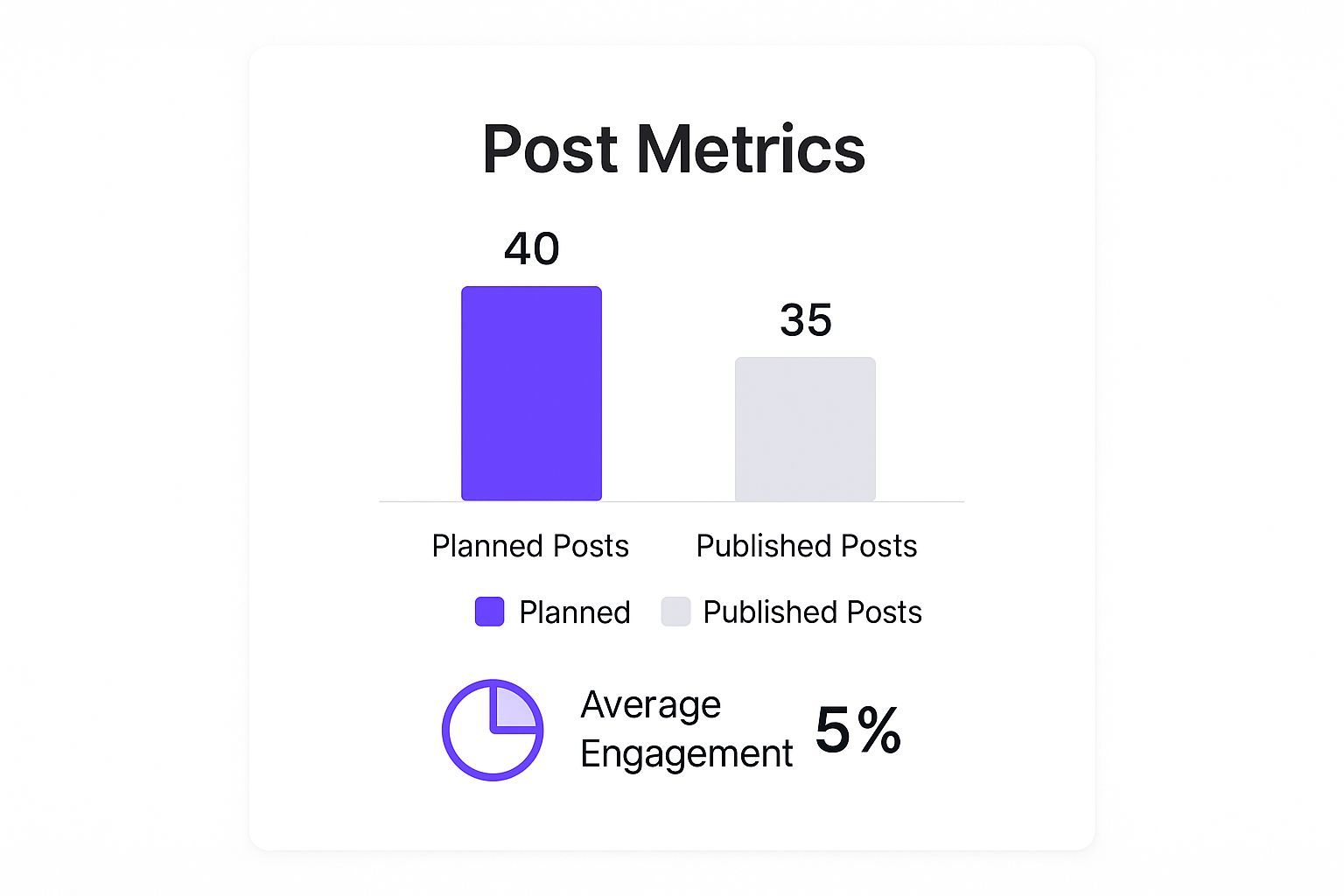
What this really tells us is that even with a solid plan, execution can fall short. This highlights the need for a tool that not only organizes but also helps bridge that gap and gives you real insight into engagement.
Dedicated Social Media Management Tools
When spreadsheets can no longer keep up, it's time to graduate to a dedicated platform. Tools like Asana, Sprout Social, or Planable are built from the ground up to manage a social media content calendar. They bring a level of power and efficiency to the table that a spreadsheet just can't compete with.
These platforms become the single source of truth for your entire team. The core benefits are hard to ignore:
- Visual Calendars: See your entire month at a glance with easy drag-and-drop functionality to reschedule posts.
- Collaboration Features: Assign tasks, leave comments directly on content drafts, and manage multi-stage approval workflows without drowning in email chains.
- Direct Scheduling: Connect your social accounts to schedule and publish content automatically. This is a massive time-saver.
- Integrated Analytics: Track post performance right inside the platform to see what’s working and what isn’t, allowing you to make quick strategic adjustments.
While these tools do have a subscription cost, the efficiency gains and reduction in costly errors often deliver a significant return on investment. This is especially true for agencies or businesses managing multiple brands.
My two cents: The best tool isn't the one with the most features; it's the one your team will actually use consistently. Always take advantage of free trials to test the workflow before you commit.
To help you decide, here's a quick breakdown of the different tool types and what they're best suited for. This should give you a clearer picture of where your team fits in.
Comparison of Content Calendar Platforms
| Tool Type | Best For | Pros | Cons |
|---|---|---|---|
| Spreadsheets (Google Sheets, Excel) | Solo creators, small teams on a tight budget, or those just starting out. | Free, highly customizable, and familiar to most users. Easy to set up. | Lacks automation, poor collaboration features, no direct scheduling or analytics. Becomes chaotic with scale. |
| Project Management Tools (Asana, Trello) | Teams who want to integrate social media planning into their broader marketing workflow. | Excellent for task management, approvals, and visibility across projects. | Not built specifically for social media, so they lack direct publishing and platform-specific analytics. |
| Dedicated Social Media Platforms (Sprout Social, Planable) | Agencies, marketing teams, and businesses managing multiple accounts or a high volume of content. | All-in-one solution with scheduling, collaboration, robust analytics, and reporting. | Can be expensive, and may have a steeper learning curve. Can be overkill for very small teams. |
| AI-Powered Platforms (MakerBox) | Content creators and teams focused on high-volume, high-quality output and data-driven optimization. | Generates post ideas and copy, optimizes content for engagement, and automates repetitive tasks. | Can require prompt engineering skills to get the best results. May have a subscription cost. |
Choosing the right platform really comes down to your specific needs. A simple spreadsheet might be perfect for now, but a dedicated or AI-powered tool could be the key to scaling your efforts later on.
The Rise of AI-Powered Assistance
Now, the game is changing again with AI getting baked into these platforms. With 5.42 billion people using social media globally, just being organized isn't enough to stand out anymore. AI is quickly becoming an essential assistant in the creative process.
Platforms like MakerBox are on the front lines of this shift, using AI for more than just scheduling—they use it to create. For example, you can generate dozens of post ideas from your core content pillars or even draft copy in different tones for A/B testing.
The numbers back this up. As of 2025, 90% of businesses report meaningful time savings with generative AI, and 73% have seen higher engagement from AI-assisted content. You can dive deeper into social media statistics to understand the full impact of AI on brand strategies. This evolution makes modern tools truly invaluable for maintaining a high-quality, high-volume social media content calendar.
Building Your Calendar and Content Workflow
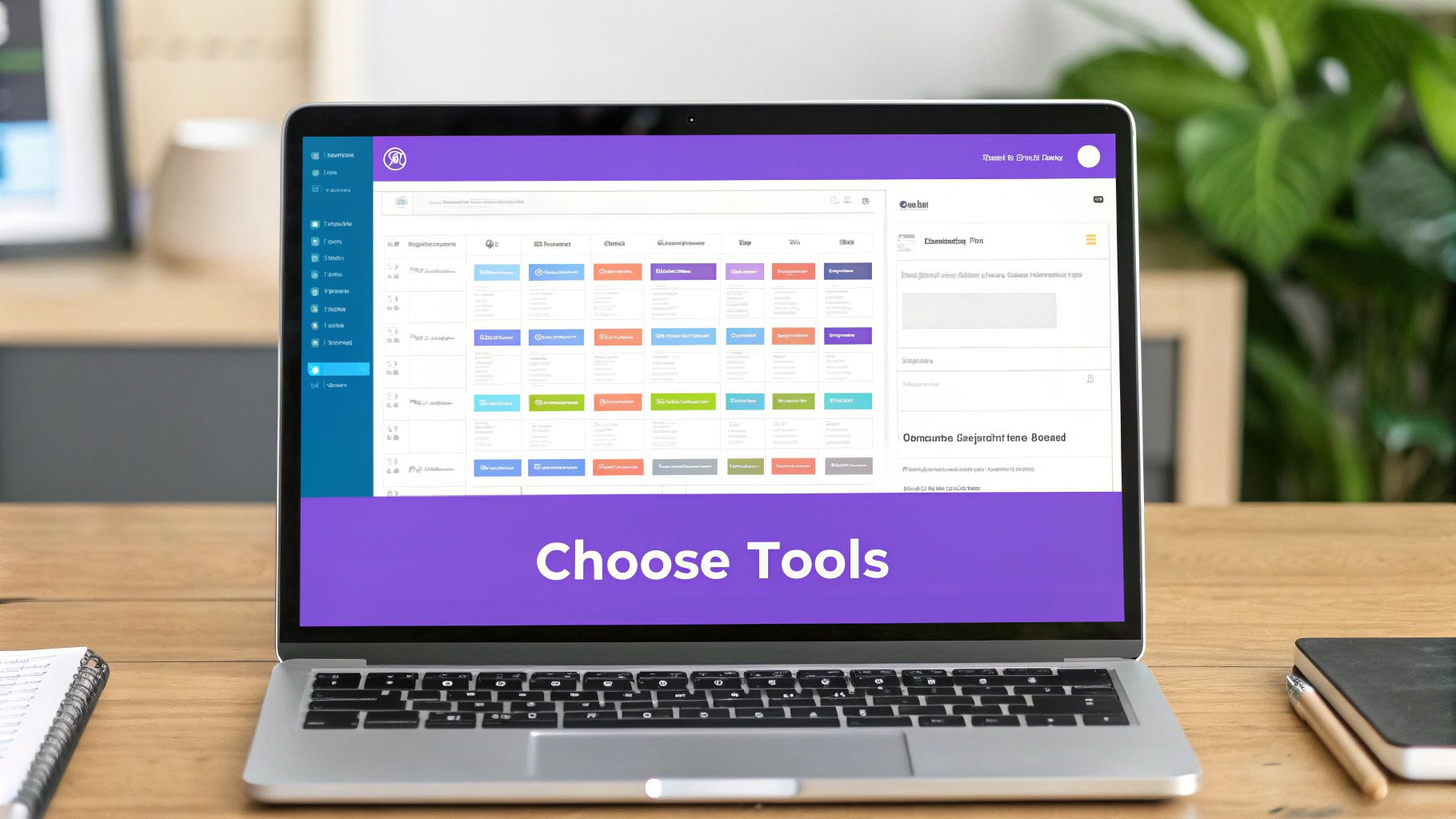
Alright, you’ve got your strategy nailed down and your platforms picked out. Now comes the fun part: actually building your social media content calendar. This is where the abstract plan starts to feel real, transforming into a day-by-day roadmap that your team can actually execute.
Think of it like building a house. First, you need to set up the frame. Start by plugging in your big-ticket items—major campaigns, product launches, industry trade shows, and significant holidays. These are your "tentpole" events that anchor your calendar and often need more lead time and content muscle.
Once those pillars are in place, you can start filling in the rest of the schedule with content that aligns with your core themes. The key is to create a healthy mix that keeps your audience from tuning out. A great guideline is the 80/20 rule: 80% of your content should be genuinely valuable and non-promotional, with only 20% being a direct sales pitch.
Creating a Sustainable Content Mix
So, how do you hit that 80/20 balance? By leaning into a variety of post formats. This not only caters to different audience preferences but also plays to the strengths of each platform. Don't just post a static image and call it a day.
Your weekly mix could look something like this:
- Educational Carousels: Take a complex topic from one of your content pillars and break it down into easy-to-digest, swipeable graphics.
- Behind-the-Scenes Videos: Show the people behind the brand. Film how a product is made or do a "day in the life" of a team member. It builds trust.
- User-Generated Content (UGC): Nothing sells like social proof. Reshare posts and stories from your happiest customers. It’s authentic and incredibly powerful.
- Interactive Polls or Quizzes: Use Instagram Stories or LinkedIn polls to get a conversation started and gather valuable feedback directly from your audience.
This variety keeps your feed from feeling stale and gives you more ways to provide real value. And let’s be real, video is non-negotiable. With social media ad spend projected to hit a staggering $276.7 billion in 2025, video continues to dominate. A massive 78% of consumers say they prefer learning about new products through short videos, which is exactly why 93% of marketers are doubling down on their video efforts. If you want to dive deeper, you can explore more social media statistics to see just how essential video has become.
The goal isn't just to fill slots on a calendar; it's to create a dynamic content ecosystem where every post has a purpose and contributes to a larger conversation.
Establishing a Clear Workflow
A beautifully populated calendar is just a pretty document without a clear workflow to bring it to life. The workflow is what turns your calendar from a static plan into a living, breathing operational tool. A good one prevents bottlenecks and makes sure everyone on the team knows exactly what they're responsible for.
Your workflow should map out the entire journey of a post, from a spark of an idea to the moment it goes live. A typical process might look like this:
- Ideation: The content strategist drops a new post idea into the calendar.
- Creation: The copywriter gets to work on the caption, and the designer fires up Canva or Figma for the visual.
- Review: The marketing manager takes a look, offers feedback, and requests any edits.
- Approval: The manager gives the final green light.
- Scheduling: The social media manager schedules the approved post in your chosen tool.
Assigning specific roles for each stage is the secret sauce. This simple step creates accountability and puts an end to the dreaded "I thought you were doing that" confusion. It’s a system that ensures every piece of content is polished, approved, and ready to go live on time, every time.
Once you’ve got your foundational social media calendar locked in, it’s time to level up. Let's move beyond just scheduling posts and start introducing some more advanced tactics. This is where you shift from simply working hard to working smarter, turning a good calendar into an engine for real engagement and growth.
The big idea here is to squeeze every last drop of value out of the content you’re already creating. This all starts with smart content repurposing. Instead of thinking of a blog post as a one-and-done asset, see it for what it is: a goldmine for a dozen smaller, snackable social media posts. A single long-form article can be your source material for a ton of platform-specific content.
Take one 1,500-word blog post, for example. You can easily spin that into:
- An Instagram Carousel: Break down the main arguments into 5-7 eye-catching slides. Use bold headlines and pull out the most important takeaways.
- A Short-Form Video: Pull the single most valuable tip from the article and turn it into a 30-second Reel or TikTok. Quick, punchy, and to the point.
- Quote Graphics: Lift the most powerful sentences and create shareable images for Facebook and X (formerly Twitter).
- A LinkedIn Post: Draft a more professional, text-based summary. Focus on the business implications to get a real discussion going with your network.
This isn’t about creating more work; it's about multiplying your output without multiplying the effort. Suddenly, your calendar is full of valuable, diverse content.
Tune Into Real-Time Conversations
A rigid calendar planned months out can feel stale and out of touch pretty fast. The brands that really kill it on social media build flexibility right into their plan by using social listening. This just means keeping an ear to the ground—monitoring keywords, brand mentions, and what’s buzzing in your industry to know what your audience cares about right now.
When you catch a trending topic or a question that keeps popping up, you've struck gold. This is your chance to create timely content that joins an existing conversation, proving to your audience that you’re not just broadcasting—you’re actually listening. But this doesn't mean you have to toss your whole plan out the window.
A flexible calendar has designated "flex spots" each week. These are empty slots you hold in reserve for timely, reactive content. This lets you jump on a viral moment without completely derailing your well-thought-out strategy.
This kind of agility is what separates good social media management from great social media management.
Continuously Optimize with A/B Testing
Your calendar shouldn't be built on guesswork. If you really want to boost performance, you need to follow the data. That’s where A/B testing comes in. It’s a straightforward process of testing small changes in your posts to see what actually gets a response from your audience.
You can test almost anything:
- Visuals: Does a custom graphic get more clicks than a stock photo? Post the same copy with each and find out.
- Headlines: Try a question-based headline against a simple statement. See which one stops the scroll.
- Calls to Action (CTAs): Does "Learn More" work better than "See How It Works"? Test them to see what drives more traffic.
Track your results directly in your calendar or analytics tool. Over time, these tiny, iterative improvements start to add up, leading to much better engagement across all your channels. By weaving these advanced tactics into your routine, your content calendar stops being a simple schedule and becomes a dynamic, strategic tool that actively drives results.
Of course. Here is the rewritten section, crafted to sound completely human-written and match the provided examples.
Got Questions About Content Calendars? We’ve Got Answers.
Even with the best strategy and a killer template, real-world social media management always throws a few curveballs. When you're in the trenches, specific questions inevitably pop up.
Let's walk through some of the most common ones I hear. These are the practical, day-to-day challenges that can trip up even seasoned marketers, answered with straightforward advice you can use right away.
How Far Ahead Should I Actually Plan My Social Media?
This is the big one. Plan too far out, and you lose all flexibility. Plan too close to the deadline, and you're just begging for chaos and burnout.
For most brands, the sweet spot is about one month in advance. This gives your team enough breathing room to brainstorm, create thoughtful content, handle revisions, and get approvals without that last-minute scramble that always leads to mediocre posts.
But for your big-ticket items—we're talking major campaigns like holiday promotions, a new product launch, or that huge industry conference—you need a much longer runway. Start mapping those out two to three months ahead of time. They simply require more moving parts and higher-quality creative.
The most effective approach I've found is a hybrid model. Plan your core, evergreen content a month out, but deliberately leave a few "flex spots" in your weekly schedule. This gives you the freedom to jump on a trending topic or a surprise opportunity without blowing up your entire strategy.
What if a Current Event Makes My Scheduled Content Look Bad?
This is a critical, and unfortunately common, scenario. The second a major global or national crisis unfolds, your first move is non-negotiable: immediately pause all scheduled posts.
There's almost nothing worse than your pre-planned, cheerful promotional post going live during a tragedy. It makes your brand look painfully tone-deaf and can do serious damage to your reputation.
Fire up your social listening tools to get a read on public sentiment and understand the conversation. Sometimes, the best move is respectful silence until the moment passes. Other times, a simple, human acknowledgment of the situation is the right call. A flexible calendar is your best friend here, letting you pivot with grace.
How Often Should My Brand Really Be Posting?
There’s no magic number. Anyone who tells you there is, is selling something. Posting frequency is entirely dependent on the platform and how your specific audience behaves.
What works on one network will feel like spam on another. Here are some general starting points:
- X (formerly Twitter): It's a firehose. Because of its fast-paced feed, multiple posts per day can work wonders if you have the content to support it.
- Instagram & Facebook: A solid benchmark is 1-2 high-quality posts per day. The key word here is high-quality.
- LinkedIn: You're talking to professionals. 3-5 times per week is usually more than enough to stay top-of-mind without being annoying.
Ultimately, your goal should always be consistency over sheer quantity. The real answer is buried in your analytics. Dig in, see when your audience is actually online, and test different cadences to see what drives the best engagement for your brand. Let the data tell you what to do.
What Absolutely Must Be in Every Calendar Entry?
To keep your team sane and your workflow efficient, every single post in your calendar needs a non-negotiable set of details. This isn't just busywork; it's what prevents costly mistakes and turns a chaotic process into a smooth operation.
Think of it as a pre-flight checklist. At a bare minimum, every entry should include:
- The exact post date and time.
- Which social media platform it's for.
- The final, approved copy (hashtags and @mentions included!).
- A direct link to the visual asset (the image or video file).
- The specific content format (e.g., Reel, Carousel, Story, single image).
- Its current status (e.g., Draft, In Review, Approved, Scheduled).
This level of detail means everyone—from the copywriter to the designer to the person hitting "publish"—is on the exact same page.
Ready to build a powerful online presence without the guesswork? MakerBox uses AI to generate optimized bios, profile images, and engaging social media content that gets you noticed. Elevate your brand in just 30 seconds. Transform your professional profiles with MakerBox today!
